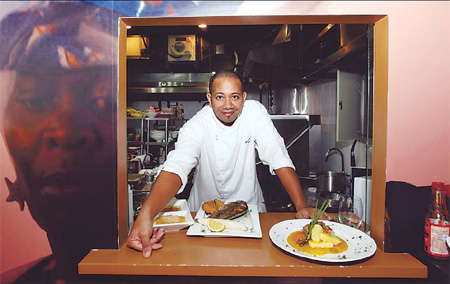|
 Rui Sa, executive chef of the restaurant in the Angola Pavilion, serves up national treats. [Gao Erqiang / China Daily] Rui Sa, executive chef of the restaurant in the Angola Pavilion, serves up national treats. [Gao Erqiang / China Daily] |
There is no crocodile but plenty of fishy stories from the chef, Matt Hodges reports.
Crocodile is off the menu at the Angola Pavilion this year, but plenty of seafood dishes are there to tempt your palate, many of them cooked with pungent flavors and sauces so distinctive even Angolans only dare eat them once a week.
"Typical Angolan food is very strong. It's so strong the people in my country don't eat it everyday, usually just on Saturdays. The rest of the time they grill fish or eat steak," said Rui Sa, the restaurant's executive chef.
"The same goes for the Chinese who come here. They try our local dishes out of curiosity, but most of them go for the steak," he said.
There are two steak dishes, one served with vegetables and the other with prawns and clams. Sa likes his steaks big (350 grams), grilled and caked in his homemade seafood sauce. Called "Mussolo", it is made with brandy and named after a pancake-flat island off the Angolan coast.
"I learned in France that if you use Cognac the food usually comes out better," said Sa, who likes to have guests experiment with his new cocktails or shots while they eat, many of them featuring African or Thai fruit.
The pavilion went for a taste of the exotic at a previous Expo held in Germany 10 years ago by serving crocodile, antelope and springbok, which are still hunted in the country, he said. But many of the dishes served at the tropical-themed restaurant this time around focus on local "fruits of the sea" in testament to the West African country's vast Atlantic coastline.
Others are infused with Portuguese flavors or cooking styles, showing the influence of over 400 years of colonization by the Portuguese.
Sa recommends two dishes with intriguing Angolan-Portuguese names: Moamba de Galinha Perfumado com Hortela (chicken with peanut sauce), which costs 180 yuan a dish; and Mufete a Moda do Mussolo com Tuberculos da Terra (Mufete fish in Mussulo style), which costs 150 yuan.
Palma cooking oil makes the dishes taste stronger still, so the chef balances them out in other ways. One example is the lemon he uses to soften the Calula Fresh and Dry Fish (170 yuan), which comes with eggplant, tomatoes, onions and cornflower.
Angolan cuisine varies among its 18 provinces and four major ethnic groups, each of which has its own favorites. The Ovimbunda tribe is said to favor maize and cassava, the Kimbundu stick closer to Portuguese recipes and the Bakongo like chicken stews and buttery sauce.
However fish, cassava products and spicy stews are popular nationwide, while the pervasive influences of Indian, Malay and European have earned Angolan food the nickname "rainbow cuisine".
The restaurant's sandwiches seem to follow the same theme, with pork fillet and pineapple combinations going for 54 yuan. There is also a selection of cakes, cheap beers (Tsingtao bottles go for 15 yuan) and plenty of cocktails (38 to 60 yuan).
Apart from the food, the restaurant wins points for its long bar, tropical ambience and fun-loving staff, headed up by bartender Jose David.
Angola hosts a party every Thursday from 9 pm, letting Expo staff and tourists unwind next to palm trees and bongo drums while musicians serenade them from an African beach via a large screen. At the bar, Sa lays out free appetizers such as quail egg with caviar and Dijon mustard.
He said he plans to stay in Shanghai after the Expo to teach at a tourism school and study Chinese cuisine, with an eye to opening a restaurant in the city.

